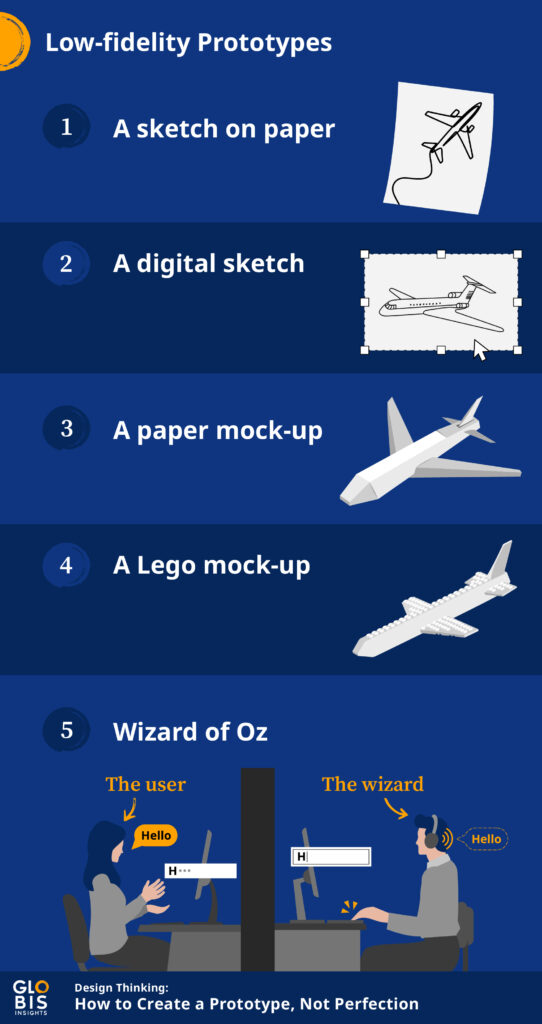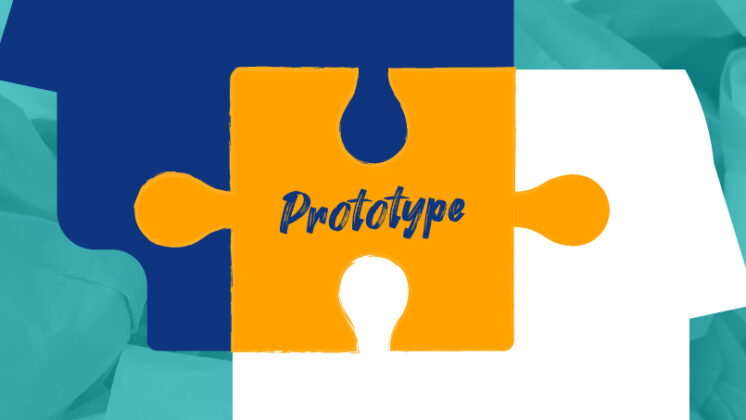In design thinking, a prototype is used to quickly bring a designer’s idea to life.
It can take the form of a digital layout, or a physical object made of less expensive material, like a paper airplane. Sometimes a prototype is scaled down, while others are true-to-size. It all depends on your budget and testing requirements.
Creating a prototype is an essential step in the design thinking process because it allows you to try out ideas and physically interact with them at an early stage.
Depending on your budget, timeline, and user testing requirements, you’ll first need to decide what type of prototype you’ll be creating: a low-fidelity prototype or a high-fidelity prototype.

Next Article
Design Thinking Principles: A How-To Guide
Low-fidelity Prototypes
The word “prototype” may conjure images of Iron Man working on his next suit, but if you find yourself without Stark-levels of cash, a low-fidelity prototype is a more reasonable option.
The goal is to get the prototype made cheaply and quickly. Try focusing on specific features that require testing, or using materials that are significantly less expensive than what would be used in final production.
While a paper version of an app may seem counterintuitive, it can help to propel the design process by creating a physical object your team can interact with. It’s suddenly more collaborative and you can see everything laid out in front of you.
Some examples of low-fidelity prototypes include:
- A digital sketch (wireframes): A simplified digital prototype of the design without wasting time on aesthetics.
- A Lego mock-up: A physical version of the design made from literal building blocks.
- Wizard of Oz Technique: A mimic of functions and features before implementing them (i.e. mimicking a voice-to-text function by having someone transcribe in the background)

When to use low-fidelity prototypes:
If you’re on a budget and need to test quickly and frequently, then low-fidelity mockups will keep the process moving. It may not withstand rigorous user testing, but it can help iron out flaws early on.
Ideate. Destroy. Revise. Repeat. When you finally land on a low-fidelity prototype that you’re confident with, you can move on to creating a high-fidelity version.
High-fidelity Prototypes
Investing in a high-fidelity prototype can definitely open up your options. One major advantage is that a high-fidelity prototype will likely withstand testing conditions that match a real-life environment.
But that doesn’t necessarily mean you need to get as close to your finished product as possible. Say you’re working on a fiberglass kayak design and need a full-scale version. Fiberglass is expensive, and you don’t want to waste material. Instead, you can make the prototype in aluminum and still have someone sit inside and paddle around.
Examples of high-fidelity prototypes
- Digital modeling: Created using a prototyping program such as Pixate or Adobe XD.
- Physical: Made using less expensive materials that behave in the same way (i.e. aluminum instead of fiberglass)
- 3D printing: A partial or full-scale version of the design but made with 3D printed components.
When to use them
It’s best not to rush directly into a high-fidelity prototype right off the bat.
Create mock-ups and iron out as many kinks as you can before investing in something more concrete. That said, here are some reasons it’s time to invest in a high-fidelity version of your design:
- To get clear estimates for materials, development time, and quality assurance testing
- To get accurate user testing data on functionality and interactivity
- To finalize visual designs
- To ensure everyone has a comprehensive understanding of the product
- To showcase the value of the product to upper management, stakeholders, investors, and other important parties

Don’t chase perfection.
Creating a prototype is design thinking is all about testing ideas dynamically. With enough trial and error, you’ll land on a prototyping method that suits the needs of your team. It’s natural to strive for perfection from the get-go. But this way of thinking can keep products in design hell with no end in sight. If you need to keep your project moving, don’t worry about a picture-perfect prototype. What matters most is that it works and that you’ve managed to identify flaws and make the necessary improvements as efficiently as possible.




